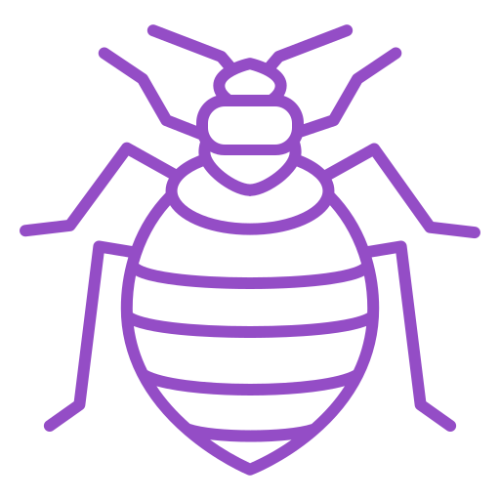Flea Control and Exterminator Service
The Best Flea Exterminator And Flea Control Services Near Me!
At SmartGreen, we've set ourselves apart by offering not only top-notch flea control but also an unparalleled commitment to excellent customer service and satisfaction. In a market dominated by larger pest control companies, we strive to change the narrative by providing personalized experiences that our customers truly deserve. Experience the difference with SmartGreen Pest and Mosquito Control – your go-to choice for eco-friendly pest solutions. Call us now for a free inspection and say goodbye to fleas the smart and green way!
We Provide Flea Control and The Following Services:
SmartGreen Pest and Mosquito Control is dedicated to exterminating and preventing pest infestations on your property. Our services eradicate the most common and even uncommon pest types. You can count on us for:
Trust SmartGreen Pest and Mosquito Control exterminators in Woodstock, Kennesaw, GA and surrounding areas to get rid of all types of insects around your property. Call (404) 937-7088 today to request eco friendly pest control at your home or office.
Understanding Fleas: Life Cycle and Habitats
Fleas are small, wingless insects that belong to the order Siphonaptera. They are known for their ability to jump long distances and their preference for feeding on the blood of animals, including pets and humans. To effectively control fleas, it is crucial to understand their life cycle and habitats.
Flea Life Cycle
The life cycle of a flea consists of four stages: egg, larvae, pupae, and adult. Understanding these stages is essential for effective flea control.
- Egg Stage: Female fleas lay eggs on the host animal, which then fall off into the environment. These eggs are tiny, oval-shaped, and typically white or translucent. Each female flea can lay hundreds of eggs during her lifetime.
- Larvae Stage: After hatching from the eggs, flea larvae emerge. They are worm-like and have a whitish color. Larvae feed on organic debris, such as flea feces and skin cells, found in the environment. They avoid light and prefer to hide in dark, humid areas like carpets, bedding, and cracks in floors.
- Pupae Stage: When the larvae have matured, they spin cocoons and enter the pupae stage. The cocoon provides protection during this developmental phase. Pupae can remain dormant for weeks or even months, depending on environmental conditions.
- Adult Stage: Once the pupae have completed their development, adult fleas emerge from the cocoons. They are small, dark brown insects with flattened bodies and strong hind legs for jumping. Adult fleas seek a blood meal from a host within a few days of emerging. The entire life cycle, from egg to adult, can take anywhere from a couple of weeks to several months.
Flea Habitats
Fleas thrive in warm and humid environments, making them more prevalent during the spring and summer months. They can be found in various habitats, including:
- Pets: Fleas often infest dogs, cats, and other furry animals. The fur provides an ideal environment for them to hide, lay eggs, and feed on blood.
- Indoor Spaces: Fleas can easily infest homes, especially if pets have access to indoor areas. They can hide in carpets, upholstery, bedding, and cracks in the floor.
- Outdoor Areas: Fleas can be found in outdoor spaces where pets spend time, such as gardens, yards, and parks. They may also reside in areas frequented by wild animals, including raccoons, squirrels, and stray cats.
Understanding the life cycle and preferred habitats of fleas is crucial for effective control and prevention strategies. By targeting each stage of the life cycle and eliminating flea habitats, you can significantly reduce the risk of infestation in your home and protect your beloved pets.
Preventive Measures: How to Keep Fleas Away
Preventing flea infestations is essential to ensure the well-being of your pets and maintain a flea-free home environment. In this section, we will explore various preventive measures that can help keep fleas away.
Maintaining Cleanliness in Pet Areas
- Regular Cleaning: Clean and vacuum your pet's bedding, carpets, and upholstered furniture regularly. This helps remove flea eggs, larvae, and pupae from the environment.
- Washing Pet Bedding: Wash your pet's bedding in hot water and dry it on high heat to kill any fleas or eggs present.
- Frequent Bathing: Regularly bathe your pets with a flea shampoo recommended by your veterinarian. This helps remove any existing fleas and prevents infestations.
- Cleaning Outdoor Spaces: Keep outdoor areas where your pets spend time clean and free from debris. Trim shrubs and grass regularly to limit flea habitats.
Regular Grooming of Pets
- Brushing: Regularly brush your pets' fur to remove any fleas, flea dirt, or debris. This also helps in early detection of any potential infestations.
- Using Flea Combs: Use a fine-toothed flea comb to comb through your pet's fur, especially around the neck, back, and belly. The comb will catch fleas and flea dirt, making them easier to spot and remove.
- Trimming Hair: Keep your pets' hair trimmed, especially in areas where fleas are commonly found, such as around the ears and tail.
Use of Flea Prevention Products
- Topical Treatments: Apply monthly topical flea treatments to your pets. These treatments are typically applied to the back of the neck and provide protection against fleas and ticks.
- Oral Medications: Consult with your veterinarian about oral flea prevention medications. These medications are ingested by your pets and work systemically to kill fleas.
- Flea Collars: Flea collars can be effective in repelling fleas and preventing infestations. Ensure that you choose a collar that is safe and appropriate for your pet's size and age.
- Environmental Treatments: Use flea control products specifically designed for your home environment. This includes sprays, powders, and foggers that target fleas in carpets, upholstery, and other areas where they may hide.
By implementing these preventive measures, you can significantly reduce the risk of flea infestations and ensure the well-being of your pets. Remember to consult with your veterinarian for personalized recommendations and guidance on the most suitable preventive measures for your specific situation.
Identifying Flea Infestations
Identifying flea infestations is crucial for prompt intervention and effective flea control. In this section, we will discuss the various signs and indicators that can help you identify if your pet or home is infested with fleas.
Physical Signs in Pets
- Excessive Scratching and Biting: Fleas cause itching and discomfort in pets. If you notice your pet scratching, biting, or licking themselves excessively, it could be a sign of fleas.
- Visible Fleas or Flea Dirt: Inspect your pet's fur and skin for fleas. Adult fleas are small, dark brown insects that move quickly. Flea dirt, which looks like black specks or pepper flakes, may also be visible in your pet's fur. Flea dirt is actually flea feces and consists of digested blood.
- Hair Loss and Irritated Skin: Flea bites can lead to hair loss, redness, and irritated skin. If you notice any patches of missing fur or signs of skin irritation, fleas may be the cause.
- Allergic Reactions: Some pets may have an allergic reaction to flea bites, known as Flea Allergy Dermatitis (FAD). Symptoms include severe itching, redness, swelling, and even open sores. If your pet exhibits these symptoms, it is important to seek veterinary care.
Presence of Fleas in Home Environment
- Flea Sightings: Spotting adult fleas in your home, especially on carpets, upholstery, or bedding, is a clear indication of an infestation.
- Flea Eggs and Larvae: Inspect your pet's bedding, carpets, and other areas where fleas may hide for signs of flea eggs and larvae. Flea eggs are tiny, oval-shaped, and typically white or translucent. Larvae are worm-like and have a whitish color.
- Flea Bites on Humans: Fleas can also bite humans, leaving behind itchy red bumps, especially on the lower legs and ankles. If you or your family members are experiencing unexplained bites, it may be a sign of a flea infestation.
Health Impacts of Flea Infestations
- Anemia: Severe flea infestations can lead to anemia, especially in young animals or pets with compromised health. Anemia is characterized by a decrease in red blood cells, which can cause weakness, fatigue, and pale gums.
- Tapeworm Infections: Fleas can transmit tapeworm larvae. If your pet ingests a flea carrying tapeworm larvae during grooming, it can result in a tapeworm infestation. Look for signs of tapeworms in your pet's feces or around the anus.
Identifying flea infestations promptly allows for timely intervention and effective flea control. If you suspect your pet or home is infested with fleas, it is recommended to consult with a veterinarian or professional pest control service for appropriate treatment options.
Effective Flea Treatment Methods
When it comes to treating flea infestations, it is important to employ effective methods that target fleas at every stage of their life cycle. In this section, we will explore various flea treatment methods to help you eradicate these pesky pests from your pets and home.
Use of Flea Control Products
- Topical Treatments: Topical flea treatments, such as spot-on treatments, are widely used and highly effective. These treatments are applied directly to your pet's skin, typically at the base of the neck, and provide long-lasting protection against fleas. They work by killing adult fleas, preventing egg development, and disrupting the flea life cycle.
- Oral Medications: Oral flea medications are available in tablet or chewable form. They are administered to pets and work systemically to kill fleas. These medications are highly effective and provide extended protection. Some oral flea medications also target other parasites, such as ticks and heartworms.
- Flea Collars: Flea collars are another option for flea treatment and prevention. They contain active ingredients that repel and kill fleas. Flea collars are easy to use and provide continuous protection for several months. It is important to choose a collar that is safe for your pet and offers the appropriate level of protection.
- Flea Shampoos: Flea shampoos are effective in killing adult fleas on contact and providing immediate relief from itching. However, their effects are temporary and do not offer long-lasting protection against fleas. They can be used as part of an integrated flea control program or for immediate relief.
Professional Flea Control Services
- Pest Control Companies: Hiring a professional pest control company that specializes in flea control can be a highly effective option, especially for severe infestations. These professionals have access to powerful insecticides and expertise in identifying and treating flea habitats in and around your home.
- Flea Foggers and Sprays: Professional-grade flea foggers and sprays are available in the market. These products are designed to treat large areas, such as entire rooms or outdoor spaces, and can effectively eliminate fleas at various life stages. However, it is important to follow the instructions carefully and take necessary precautions when using these products.
Natural Home Remedies for Flea Control
- Diatomaceous Earth: Diatomaceous earth is a natural powder made from fossilized algae. It is safe for pets and humans but lethal to fleas. Sprinkle diatomaceous earth in areas where fleas are likely to hide, such as carpets, bedding, and cracks in the floor. The powder damages the fleas' outer shell, causing dehydration and death.
- Essential Oils: Certain essential oils, such as lavender, peppermint, and eucalyptus, have flea-repellent properties. Dilute a few drops of essential oil in water and spray it on your pet's bedding or brush. However, it is important to use essential oils with caution and consult with a veterinarian for appropriate dilution ratios and safety guidelines.
- Flea Traps: Flea traps can be used as a natural method to monitor and capture adult fleas. These traps contain a sticky surface or a light source that attracts fleas. Place the traps in areas where fleas are likely to be present, such as near your pet's bedding or in rooms with high flea activity.
It is important to choose the most appropriate flea treatment method based on the severity of the infestation, the specific needs of your pets, and the recommendations of your veterinarian. Combining multiple treatment methods and maintaining regular preventive measures will help ensure effective flea control and prevent future infestations.
Maintaining a Flea-Free Environment
Once you have successfully treated a flea infestation, it is crucial to maintain a flea-free environment to prevent reinfestation. In this section, we will discuss key steps and practices to help you maintain a flea-free home environment.
Periodic Checking for Fleas
- Regular Pet Inspections: Continuously monitor your pets for any signs of fleas, such as excessive scratching or visible fleas in their fur. Comb your pet's fur with a fine-toothed flea comb to check for fleas or flea dirt.
- Frequent Home Inspections: Conduct regular inspections of your home, paying close attention to areas where fleas are likely to hide, such as carpets, upholstery, and cracks in the floor. Look out for any signs of flea eggs, larvae, or adult fleas.
Ensuring Continuous Preventive Measures
- Consistent Use of Flea Prevention Products: Continue using flea prevention products, such as topical treatments or oral medications, as recommended by your veterinarian. These products provide ongoing protection against fleas and help prevent reinfestation.
- Regular Cleaning and Vacuuming: Maintain a clean living environment by regularly cleaning and vacuuming your home. Pay special attention to areas where fleas are likely to hide, such as carpets, furniture, and pet bedding. Dispose of the vacuum bag or empty the canister promptly to prevent fleas from reinfesting your home.
- Launder Pet Bedding and Linens: Wash your pet's bedding, as well as any linens and fabrics that may come into contact with your pets, in hot water. This helps kill any fleas or eggs that may be present.
- Outdoor Pest Control: If your pets spend time in outdoor areas, consider implementing appropriate pest control measures to reduce the risk of fleas. This may include treating outdoor spaces with flea control products or keeping grass and shrubs trimmed to minimize flea habitats.
Importance of Vet Check-ups
- Regular Veterinary Visits: Schedule regular check-ups with your veterinarian to ensure your pets are in good health and free from fleas. Your veterinarian can provide guidance on flea control, recommend suitable preventive measures, and address any concerns or issues related to flea infestations.
- Yearly Flea Prevention Plan: Work with your veterinarian to develop a comprehensive flea prevention plan tailored to your pets' specific needs. This may include a combination of preventive products, regular check-ups, and recommendations for flea control in your home environment.
By consistently implementing these practices and maintaining preventive measures, you can significantly reduce the risk of flea infestations and maintain a flea-free environment for your pets and family. Remember, prevention is key to keeping fleas at bay and ensuring the well-being of your beloved pets.
Thinking About Getting Flea Control?
Due to the life cycle of a flea which is called "Complete Metamorphosis" fleas are extremely difficult for a Homeowner to control. It is not enough to kill the adult fleas, you must also contend with the egg, larvae and pupae. A SmartGreen professional will perform a thorough inspection which includes interviewing the customer to get a better understanding of the customer's issues and concerns. After completing the inspection and interview process, SmartGreen will determine the best approach for eliminating these pests.
Call (404) 937-7088 today schedule today with
SmartGreen Pest and Mosquito Control for your Flea Control services.
Reasons to Choose Us for Flea Control Services:
- We offer a 30 day guaranteed interior service.
- We offer a one-time interior service.
- We also offer an exterior service which can be combined with interior







